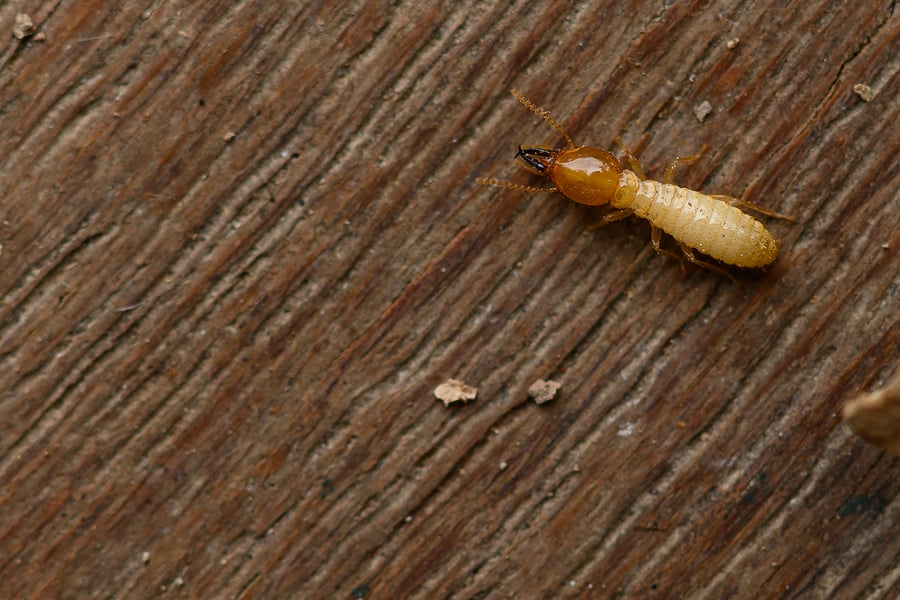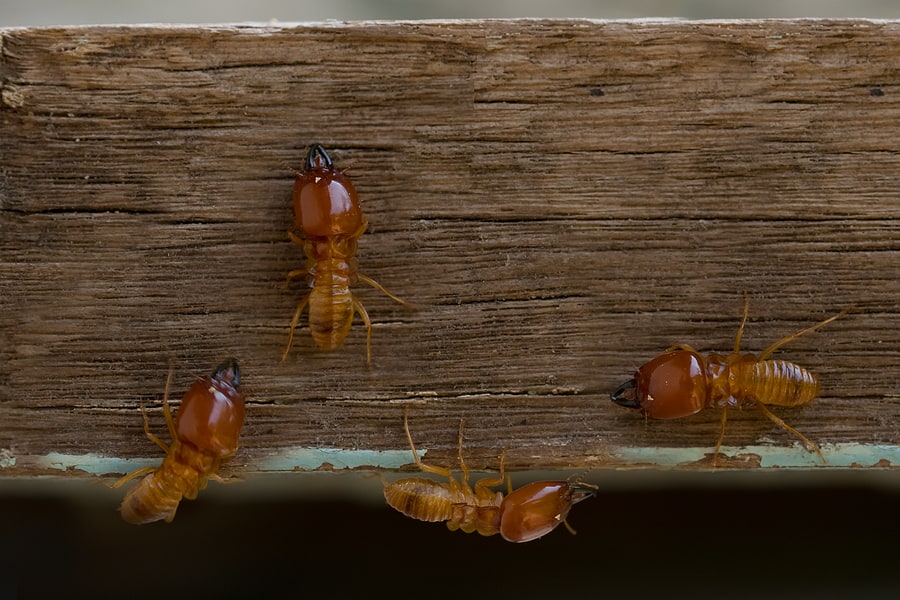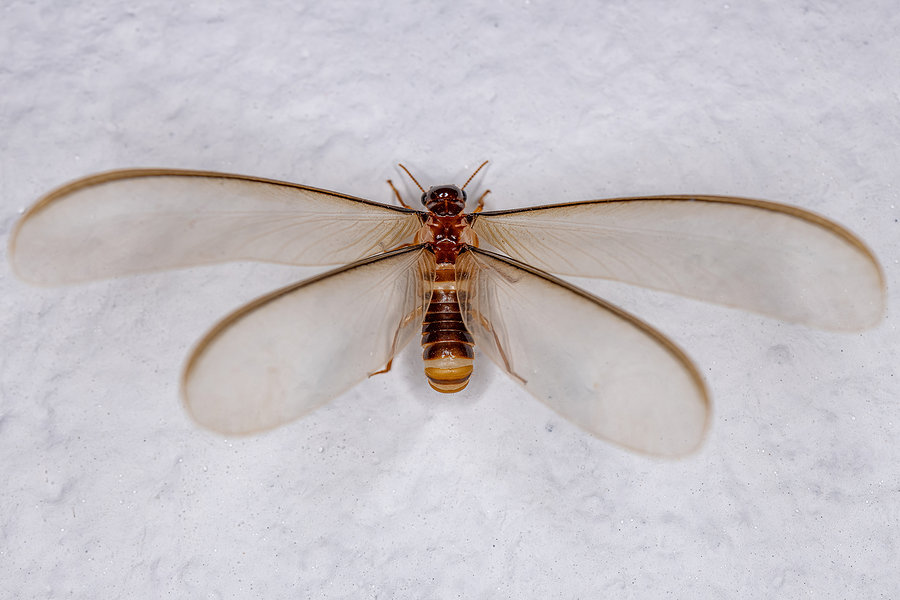READY TO GET STARTED?
REQUEST A FREE ESTIMATE
Fill out the form below or call (888) 466-7849 for a free, no-obligation estimate.

Termites are considered a year-round pest, causing significant destruction to homes and properties each year. Termite swarming season runs from spring to summer for most species. They use this time to reproduce and establish new colonies. Keep your home safe from termites this summer with these termite prevention tips.
Termite inspections aren’t limited to just your house. Make sure to inspect any wooden structures you have outside, as well, like wood furniture, swing sets, and decks. Termites will make small pinholes in the wood they are eating. If you find evidence of termites in your wooden structures, contact a termite control professional immediately. If your structures are not infested, seal them with an outdoor paint or sealant.
Installing a barrier to entry for termites will go a long way towards keeping them out of your home for good. There are two termite treatment options available for the perimeter of your home: bait stations and liquid soil treatments. In addition to these, performing routine inspections of the outside of your home, especially around foundations, is critical. If any gaps or cracks are found, seal or repair them immediately.
Stacks of firewood are an ideal food source for termites. Try not to stack firewood next to your home, shed or garage. Instead, store it several feet away from these structures. You should also elevate it, if possible, on either metal or concrete racks.
It’s important to keep your yard maintained to help prevent termites and other pests. Keep bushes and trees trimmed back so they are not touching your house or overhanging. Remove any dead or dying shrubs from your yard. Try to avoid using wooden mulch; instead, opt for recycled rubber mulch.
Termites don’t take days off so your home is always at risk. They can also go undetected for long periods of time, causing significant damage before you even realize they are there. A pest control professional can perform an annual termite inspection to help spot any signs of termites before they turn into a full blown termite infestation.
If you have a problem with termites or just want to get a head start on prevention, contact your local pest control company for a complete evaluation.
Why Do I Have Ants in My Kitchen?

Termites cost homeowners billions of dollars each year. Known as silent destroyers, these pests eat wood from the inside out, going long periods of time undetected in your home. Treating termites depends on the type of termite you have. The most common are drywood termites, dampwood termites, and subterranean termites.
You can protect your home from termites by having an annual termite inspection performed on your home. A termite technician will come out once a year and inspect the inside and outside of your home for signs of termites. You can also help prevent termites by keeping soil around your home dry, making sure landscaping doesn’t touch foundations, fixing leaks, and using concrete for foundations.
Sometimes despite our best efforts, termites invade our home. Once they get in, professional termite treatments are necessary to completely eliminate the infestation. The type of treatment you use depends on the type of termite you have. The three most common types of treatments include liquid-soil treatments, bait stations, and sprays/foams.
One of the most important questions any homeowner wants to know when treating termites is how long the treatment takes to work.
Termites can be a big headache for homeowners. If you have a problem with termites or just want to get ahead with prevention, contact a pest control company who can provide you with a thorough inspection and termite control plan that works best for your situation.
What Types of Grasses Work for My Georgia Lawn?
5 Signs You May Need an Exterminator
Termites can cause serious damage to your home, affecting both its structure and integrity. Termite damage can also be costly to repair. Let’s take a closer look at how to recognize when you have a termite problem, as well as the different types of termite treatments that are available today.
The first step in preventing termites is to identify when you have a problem. Termites eat wood from the inside out so they often go undetected for long periods of time, causing substantial damage before you even realize you have a problem. Recognizing the signs of termites in your home is a good first step to identifying their presence. Common signs of termites include:
The best way to control termites is to prevent them in the first place. Some common termite prevention tips include:
Once you have an established termite infestation, the next step is deciding which termite control treatment is best for your situation. Treatments depend on a variety of factors including the type of termite you are dealing with, the severity of the infestation, the type and size of your home, whether it is a new construction or an existing home, the cost of the treatment, and more. There are four main types of termite treatments:
Liquid-soil termite treatments are used on the soil surrounding your home to act as a treatment barrier. They are long lasting, providing protection for an average of 5 years. With these treatments, a trench is dug around the perimeter of your home and liquid termiticide is applied. The trench is then filled back in. This method helps prevent future infestations, as well as killing any existing termites as they travel between your home and their nests.
Bait station treatments are another option for treating termites. In this method, bait stations are strategically placed around your home. Each station contains a slow-acting termiticide that the termites take back to their nests and share with other termites. These treatments can take longer to affect termites. They also require regular monitoring and maintenance to make sure each station still contains bait.
Wood treatments offer another alternative to termite control. These treatments utilize either surface sprays and treatments or injected sprays and foams. Wood treatments kill existing termites and also soak into the wood to prevent future problems. These treatments require direct access to infested wood which can be difficult to get to in some circumstances. Sprays are better for use in new construction treatments as the wood can be treated as the house is being built. Injected foams are better for use on existing structures as they can expand into cracks and crevices that sprays may not be able to reach.
Pre-treated building materials are best used for new construction. The termiticide can either be sprayed or brushed on. Termiticide can also be applied anywhere the new structure comes into contact with the soil, allowing the soil to be pretreated. Using pressure treated wood is also an option as termites are less likely to infest wood that has been mixed with chemicals.
Termites are a serious problem for homeowners. If you suspect you have a problem with termites or other pests, contact your local pest control company for an inspection.
Protecting Your Pets from Fleas and Ticks
What Happens During the Bee Relocation Process?
When Should Mosquito Treatments Start?

It’s Termite Awareness Week, and termites are a known threat to southern homeowners. Termites can cause more than 5 million dollars in property damage throughout the United States, and it is normal for this damage not to be covered by homeowner’s insurance policies. Before the damage gets out of control, look for termite signs and consider getting a preventative termite treatment and warranty from professional help.
One of the first signs that termites are near is if you encounter swarmers near your home. Although swarmers do not cause wood damage, they do indicate that a colony is nearby. If you notice swarmers, it’s best to take immediate action and have a local termite control company take a look.
Another tell-tale sign that termites are close by is the presence of mud tubes or tunnels along the foundation of your home. Termites use mud tubes to keep moisture when traveling to and from their colony and your home.
Some other signs of termites that you may notice are:
Even if you do not find signs of termites, now is still the perfect time to get preventative termite protection! With the Sentricon Always Active bait system, you’ll experience 24/7 termite protection, annual inspections, a lifetime termite warranty, and more! Reach out to your local pest control company to help identify the type of termite and recommendations on the best treatment plan.

Swarming termites, also known as alates, are termites with wings that leave their colonies with two purposes in mind: reproducing and establishing a new colony. Alates resemble flying ants and will colonize anywhere with a cellulose source and adequate moisture for survival, making your home the ideal environment for a new colony. While alates don’t bite, sting, or eat wood, they are a good indication that there is a termite colony nearby.
Once the original termite colony reaches capacity and is ready to expand, termite swarms occur. These usually happen once per year, although some species will swarm multiple times. Swarms can contain anywhere from hundreds to thousands of alates whose sole purpose is reproduction and expansion of the colony. Once environmental conditions are right, the swarmers will launch themselves into the air and pair off. Once they’ve found their partner, both will shed their wings, mate, and find a new place to nest.
The timing of termite swarms depends on the type of termite you are dealing with. Subterranean termites typically swarm in the spring during daylight hours. Drywood termites swarm in late summer and early fall, and dampwood termites swarm over the summer. Termites will swarm once conditions are ideal, usually the day after a rain shower with overcast weather and winds less than 6 mph. Damp soil after a rainstorm also helps with nest building.
If a colony is already established inside your home, termites may swarm inside. These alates will try to squeeze through cracks and crevices in your foundations and walls to reach open air. Alates are also attracted to light so they can often be found near windows and light fixtures.
Termite swarms vary depending on what species it is. Drywood termite swarms are usually smaller than other termites with less than 100 swarmers. They will swarm in late summer and fall. Due to the small size of the swarm, you may not see the signs of drywood termites until they are already established. Dampwood termites swarm in the summer months. They are of less concern to homeowners as houses don’t typically have the moisture content necessary for them to survive. They can, however, be found in wood structures surrounding homes, e.g. utility poles. Subterranean termites are the most common and have the largest swarms, sometimes numbering into the thousands. These termites swarm in the spring between March and June.
While swarms don’t necessarily mean you have a termite infestation in your home, they are a good indicator that there is a thriving colony nearby. If you spot swarming termites in or near your home, consider a termite inspection to help identify signs of termites you may have missed and ensure you don’t have a hidden colony eating your home from the inside out.
If you suspect termites, contact a professional pest control company who can give your house a thorough inspection and help with a termite control and prevention plan going forward.
How Do I Know if I Have Bed Bugs?
Preparing Your Lawn for Spring
Millipede vs Centipede – Which Is More Dangerous?